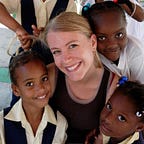Building a School in the African Jungle
A community with no roads, accessible only by dugout canoe, comes together to build a school
School is out for the day, but the children are all still working. They roll a little piece of cloth over the crown of their head and one by one, they help each other stack heavy red bricks on top. One, two, three, even four bricks high they stack them—as far as their hands can reach to steady them. The biggest boys take five.
Then they take off in a line, down to the paddy where Children of the Nations (COTN) grows rice for their lunch, across a few makeshift log bridges, and finally to the vehicle that will transport the bricks the rest of the way to the village of Mokpangumba.
This isn’t child labor. The kids are volunteers. They are helping build a school.
Once they drop them into the vehicle—which they call the “tiller,” a sort of tractor—the bricks will make the long journey across a newly-cleared dirt road to the river. Before, the only road that led to the river was a narrow footpath. The people of Mokpangumba worked long and hard to clear this new road so they could build this school.
The journey isn’t over when they make it to the river, though. The people of Mokpangumba are waiting by the shore to load the bricks into dugout canoes and ferry them across. Once on the other side, the bricks go back on heads, as the people of Mokpangumba transport them up the steep bank, through their village, and to the school site.
What are all these people doing, building a school so far away from construction materials, in such a difficult location? The story goes back ten years, to the beginning of COTN’s ministry in Upper Banta, Sierra Leone.
When COTN first set up a school in a small village called Ngolala Junction, children would walk more than five miles to attend. One group of children had a particularly long and treacherous journey, yet the tiniest students would continue to faithfully walk every day. They were coming from across the river—the village of Mokpangumba.
Mokpangumba had a school, a long time ago. Missionaries had started a small school in this village more than two decades ago. But when the country plunged into civil war, the school fell into disrepair. The people never resurrected it. After the war, children simply did not attend school.
So when a school finally opened within walking distance of their village, the children came in droves. This was their only opportunity to get an education. Group by group the tiny children—some as young as kindergarten—would climb into the canoes and cross the river. Then they’d begin the hour-long walk through jungle and farmland before they made it to class.
It quickly became apparent that these dedicated students needed a school in their village. There weren’t any resources for a school, but COTN staff started one anyway. Mr. Foday, a teacher at the school in Ngolala, moved his family out to the little village, and became the head teacher in 2007. They met in a one-room hut made of mud and sticks. Makeshift stick dividers separated four classes inside, each of the classes facing a different wall. A few classes met outside, under a tree.
For years the school carried on this way, Mr. Foday at the helm, pouring every ounce of time and energy into his students. The building was constantly crumbling or leaking, and outdoor classes were challenging in the rainy season. But the kids kept coming, the teachers kept teaching, and the Mokpangumba school became known for its high achievement.
Finally in 2011, COTN began raising money for a permanent school building in Mokpangumba. The outpouring of support was overwhelming. It didn’t take long before the COTN staff was faced with a problem—a fully funded school in a village that was almost logistically impossible to transport supplies to.
Three years later, after the people of Mokpangumba donated and cleared the land, built a road, and agreed to help with labor, construction finally began.
Today everyone, from the children, to COTN staff, to the parents and elders of Mokpangumba, is helping make this school happen. Mr. Foday has big dreams for it. “The school keeps growing,” he says. “We have ninety-eight pupils now, but we have over two hundred children in this village, plus one hundred more in the surrounding villages. One day, we will be able to accommodate them all.”
Do you want to be part of this amazing project? Help the people of Mokpangumba build their school with a gift today!
